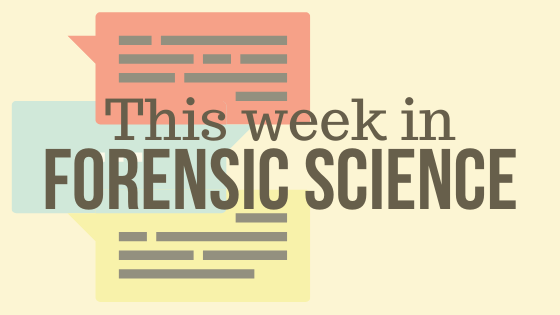No one has hours to scour the papers to keep up with the latest news, so we’ve curated the top news stories in the field of Forensic Science for this week. Here’s what you need to know to get out the door!
Why are You Publicly Sharing Your Child’s DNA Information? (The New York Times – 1/2/2020)
By uploading their children’s genetic information on public websites, parents are forever exposing their personal health data.
NY Crime Labs Face Backlogs as Criminal Justice Reforms Take Hold (Times Union – 1/4/2020)
New York crime laboratories, many of which are already backlogged and only able to test evidence in a low percentage of criminal cases, could be stretched further by new speedy trial and pre-trial discovery reforms that went into effect this month.
Recent Discoveries have Overhauled Our Picture of Where Humans Came From, and When (Science Alert – 1/6/2020)
- As researchers make more of these breakthroughs, the human evolutionary puzzle gets more complicated.
Washington AG Proposes Establishment of Statewide Cold Case Unit (Forensic – 1/6/2020)
To help with the approximately 1,600 unsolved homicide cases, as well as 1,774 unsolved sexual assault cases, Washington AG Bob Ferguson is proposing a budget that includes eight senior investigators, an assistant attorney general, a crime victim advocate, a violent crime analyst, a data consultant and a legal assistant.
New Oregon Law Opens Up Process for Post-Conviction DNA Testing (OPB – 1/6/2020)
The new measure amends statutes previously introduced in 2015 that said someone requesting a DNA test would have to show that specific evidence would lead to finding that they were “actually innocent,” in effect having to vouch for their innocence before DNA could even be tested.
Remains of Minnesotan Navy Seamen Killed During Pearl Harbor Identified through DNA Analysis (CBS 4 WCCO – 1/6/2020)
In 1947 officials with the American Graves Registration Service disinterred the remains to identify them. The staff was only able to confirm the identities of 35 of the men aboard the USS Oklahoma at that time.
In November 2015, DPAA personnel decided to exhume the remains again. Scientists used, “dental and anthropological analysis along with mitochondrial DNA and Y-chromosome DNA analysis,” to identify the remains of Lloyd R. Timm.
Half of Brits OK with Police Using DNA Supplied for Ancestry Analysis for Crime Investigations (Biometric Update – 1/6/2020)
More than half of British adults (55%) believe DNA databases collected by private companies to analyze ancestry should be used in police crime investigations, found a YouGov survey, but only five percent have actually used such services to investigate their family history or health history and event paternity, writes The Telegraph.
Forensic Reconstruction Puts a Face on B.C.’s Unidentified Dead (CBC – 1/6/2020)
Art and science collide at New York workshop where sculptors hope to help solve cold cases
US to Start Collecting DNA from People Detained at Border (The New York Times – 1/6/2020)
The information would go into a massive criminal database run by the FBI, where it would be held indefinitely. A memo outlining the program published Monday by the Department of Homeland Security said U.S. citizens and permanent residents holding a “green card” who are detained could be subject to DNA testing, as well as asylum seekers and people entering the country without authorization. Refusing to submit DNA could lead to a misdemeanor criminal charge, the document said.
‘The CSI Effect’: Women Flock to Forensics After TV Shows Depict Women in Lead Scientific Roles (19 News – 1/6/2020)
Real-life CSI investigator dispels the fiction and describes what it takes to do the job
Hobbyist DNA Services may be Open to Genetic Hacking (EurekAlert – 1/7/2020)
Online services that allow users to upload their genetic information, research genealogy and find lost relatives may be vulnerable to a sort of genetic hacking, according to two geneticists at the University of California, Davis. A paper describing the work is published Jan. 7 in the journal eLife.
‘An Incredibly Powerful Tool’, DNA Database, Turns 30 (MPR News – 1/7/2020)
It all started 30 years ago with a batch of 900 DNA samples from sexual assault crimes in Minnesota. Those samples were tested and logged as part of an FBI pilot program, together with samples from several other states. The idea was to create a database of DNA samples from crime scenes and convicted offenders that could be searched.
Country’s First Non-Profit DNA Lab Prepares for April Opening in Utah (KJZZ – 1/7/2020)
When it opens in April, Intermountain Forensics will be the first-of-its-kind DNA forensics lab in the country, according to one of its founders.
ANDE Corporation is Honored with CES 2020 Innovation Award (Yahoo! – 1/7/2020)
ANDE Corporation (https://www.ande.com/), the global leader in Rapid DNA Human Identification, today announced it is starting the new year off as the recipient of a distinguished CES 2020 Innovation Award in the “Tech for a Better World” category. CES is showcasing the honorees at its annual conference this week in Las Vegas, NV.
STRmix will be Used in San Antonio, Golden, and Tucson Forensic Labs (CISION – 1/9/2020)
Forensic labs in San Antonio, TX, Golden, CO, and Tucson, AZ have announced they will begin using STRmix™ to resolve DNA profiles in criminal investigations.
Sophisticated forensic software that can be used to resolve mixed DNA profiles previously thought to be too complex to interpret, STRmix™ is being regularly used in 51 forensic labs throughout the U.S. Another 60 U.S. forensic labs are now in various stages of STRmix™ installation, validation, and training.
WOULD YOU LIKE TO SEE MORE ARTICLES LIKE THIS? SUBSCRIBE TO THE ISHI BLOG BELOW!
SUBSCRIBE NOW!


